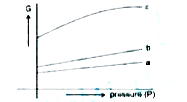Calculate the maximum work done (in multiple of 103) in expanding 16g of oxygen at 300K and occupying a volume of 5dm3 isothermally, until the voume becomes 25dm3 (Give you anwer as nearest integer)Solution in Telugu
The correct Answer is:2
Step by step video, text & image solution for Calculate the maximum work done (in multiple of 10^(3)) in expanding 16g of oxygen at 300K and occupying a volume of 5 dm^(3) isothermally, until the voume becomes 25 dm^(3) (Give you anwer as nearest integer) by Chemistry experts to help you in doubts & scoring excellent marks in Class 12 exams.
Topper's Solved these Questions
- BOOK - AAKASH SERIESCHAPTER - CHEMICAL THERMODYNAMICSEXERCISE - Practice Sheet- Exercise-II30videos
CHEMICAL THERMODYNAMICS
- BOOK - AAKASH SERIESCHAPTER - CHEMICAL THERMODYNAMICSEXERCISE - Practice Sheet- Exercise-III30videos
CHEMICAL THERMODYNAMICS
- BOOK - AAKASH SERIESCHAPTER - CHEMICAL THERMODYNAMICSEXERCISE - Lecture Sheet -Exercise-IV16videos
CHEMICAL THERMODYNAMICS
- BOOK - AAKASH SERIESCHAPTER - CHEMICAL KINETICSEXERCISE - Objective Exercise - 4 (Assertion (A) & Reason (R) Type Questions)44videos
CHEMICAL KINETICS
- BOOK - AAKASH SERIESCHAPTER - CHEMISTRY IN EVERY DAY LIFEEXERCISE - PRACTICE EXERCISE29videos
CHEMISTRY IN EVERY DAY LIFE
Similar Questions
Assertion: Under adiabatic free expansion, (dUdV)T is +ve when attractive forces are dominant between gas molecules [U,V,T respresent internal energy, volume and temperature of gas respectively]
Reason: Internal energy is a state function.05:41View SolutionThe following curve represents the variation of Gibbs function 'G' with pressure at constant temperature. Correct match of given plots with the physical state of a substance is
 01:48View Solution
01:48View SolutionFor a reaction R1,ΔG=xKJmol−1. For a reaction R2,ΔG=yKJmol−1. Reaction R1 is non-spontaneous but along with R2 it is spontaneous. This means that
View Solution(A) Spontaneous reaction may be slow or fast.
(R ) Spontaneous nature deals with feasibility of the reaction but not rate.View SolutionAnti allergy drugs are
03:09View SolutionCalculate the maximum work done in expanding 16g of oxygen at 300K occupying volume of 5dm3 and isothermally untill the volume become 25dm3?
02:47View Solution16g of oxygen gas expands isothermally and reversibly at 300 K from 10 dm^(3) to 100 dm^(3) . The work done is ( in J)
03:36View Solution16 g off oxygen gas expands isothermally and reversibly at 300 K from 10 dm^(3) to 100 dm^(3) . The work done is (in J)
03:17View SolutionCertain gas expands from 10dm3 to 35dm3 isothermally by absorbing 413 KJ of heat. What is the work done ?
04:08View SolutionThe maximum work done in expanding 1.6×10−2 oxygen at 300 k and occupying a volume of 10cm3 isothermally until the volume of 10dm3 isothermally unti the volume becomes 50dm2is(R=8.314JK6−1mol−1)
01:11View SolutionThree moles of an ideal gas at 27∘C are compressed reversibly and isothermally from a volume of 10dm3 to 5dm3. Calculate the work done on the gas.
06:52View SolutionAt 400K, 5 moles of an ideal gas expands isothermally and reversibly from 10dm3 to 20dm3. Calculate the work done by the gas.
03:16View Solution0.14kg of nitrogen at 300K is expanded isothermally and reversibly until its volume becomes doubled. Calculate the work done by the gas.
01:52View SolutionThe maximum work done in expanding 16 g oxygen at 300K and occupying a volume of 5 dm3 isothermally until the volume become 25 dm3 is:
04:19View SolutionOne mole of a gas occupying 3 dm^3 expands against constant external pressure of 1 atm to a volume of 13 dm^3. The work done is:
View Solution

